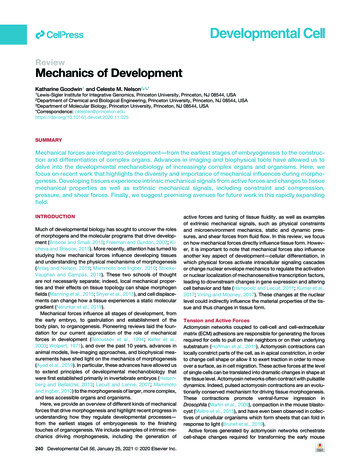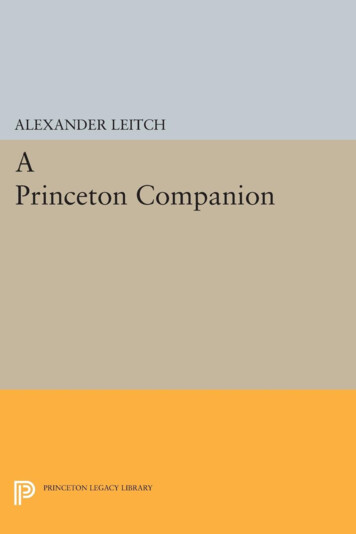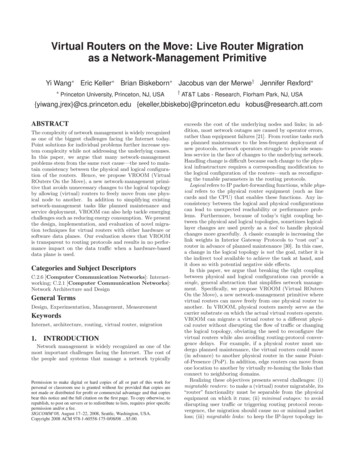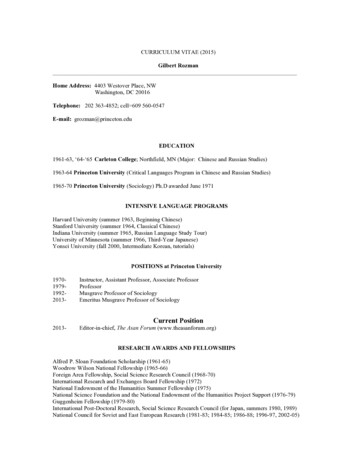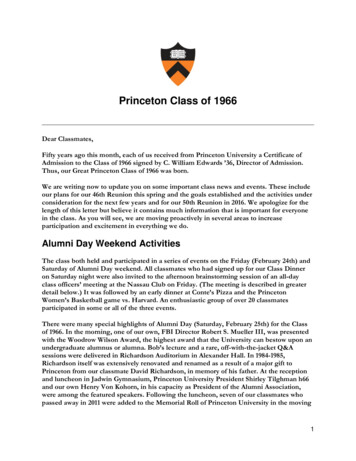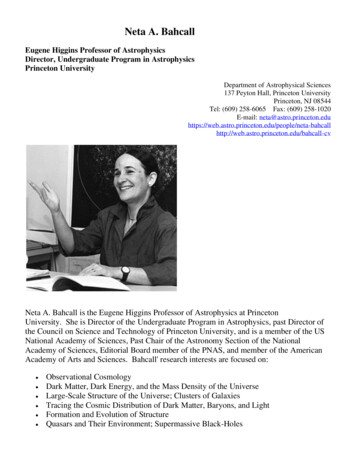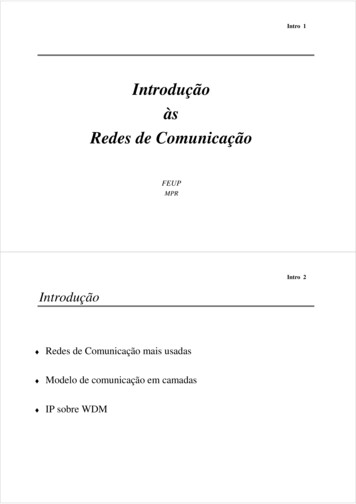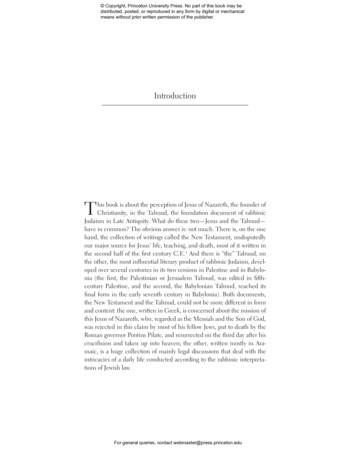
Transcription
Copyright, Princeton University Press. No part of this book may bedistributed, posted, or reproduced in any form by digital or mechanicalmeans without prior written permission of the publisher.IntroductionThis book is about the perception of Jesus of Nazareth, the founder ofChristianity, in the Talmud, the foundation document of rabbinicJudaism in Late Antiquity. What do these two—Jesus and the Talmud—have in common? The obvious answer is: not much. There is, on the onehand, the collection of writings called the New Testament, undisputedlyour major source for Jesus’ life, teaching, and death, most of it written inthe second half of the first century C.E.1 And there is “the” Talmud, onthe other, the most influential literary product of rabbinic Judaism, devel oped over several centuries in its two versions in Palestine and in Babylo nia (the first, the Palestinian or Jerusalem Talmud, was edited in fifthcentury Palestine, and the second, the Babylonian Talmud, reached itsfinal form in the early seventh century in Babylonia). Both documents,the New Testament and the Talmud, could not be more different in formand content: the one, written in Greek, is concerned about the mission ofthis Jesus of Nazareth, who, regarded as the Messiah and the Son of God,was rejected in this claim by most of his fellow Jews, put to death by theRoman governor Pontius Pilate, and resurrected on the third day after hiscrucifixion and taken up into heaven; the other, written mostly in Ara maic, is a huge collection of mainly legal discussions that deal with theintricacies of a daily life conducted according to the rabbinic interpreta tions of Jewish law.For general queries, contact webmaster@press.princeton.edu
Copyright, Princeton University Press. No part of this book may bedistributed, posted, or reproduced in any form by digital or mechanicalmeans without prior written permission of the publisher.2IntroductionMoreover, and here things become much more complicated, with thejuxtaposition of “Jesus” and the “Talmud” bordering on an oxymoron,both stand in a highly charged and antagonistic relationship with eachother. The Jewish sect triggered by Jesus in Palestine would eventuallyevolve into a religion of its own, a religion to boot that would claim tohave superseded its mother religion and position itself as the newcovenant against the old and outdated covenant of the people of Israel bybirth. And at precisely the time when Christianity rose from modest be ginnings to its first triumphs, the Talmud (or rather the two Talmudim)would become the defining document of those who refused to accept thenew covenant, who so obstinately insisted on the fact that nothing hadchanged and that the old covenant was still valid.Yet strangely enough, the figure of Jesus does appear in the Talmud,as does his mother Mary—not in a coherent narrative, but scatteredthroughout the rabbinic literature in general and the Talmud in particu lar2 and often dealt with in passing, in conjunction with another subjectpursued as the major theme. In fact, Jesus is mentioned in the Talmud sosparingly that in relation to the huge quantity of literary production cul minating in the Talmud, the Jesus passages can be compared to theproverbial drop in the yam ha-talmud (“the ocean of the Talmud”). Theearliest coherent narrative about Jesus’ life from a Jewish viewpoint thatwe possess is the (in)famous polemical tract Toledot Yeshu (“History ofJesus”), which, however, took shape in Western Europe in the early Mid dle Ages, well beyond the period of our concern here (although, to besure, some earlier versions may go back to Late Antiquity).3So why bother? If the rabbis of rabbinic Judaism did not care muchabout Jesus, why should we care about the few details that they do trans mit, apart from simply stating the fact that they did not care much? This isone possible approach, and, as we will see, the one that has been taken inthe most recent research on our subject. But I do not think that it is an ap propriate response to the problem posed by the admittedly meager evi dence. First, the question of Jesus in the Talmud is, of course, part of themuch larger question of whether and how the nascent Christian move ment is reflected in the literary output of rabbinic Judaism. And here weare standing on much firmer ground: Jesus may not be directly men tioned, but Christianity, the movement that he set in motion, may well beFor general queries, contact webmaster@press.princeton.edu
Copyright, Princeton University Press. No part of this book may bedistributed, posted, or reproduced in any form by digital or mechanicalmeans without prior written permission of the publisher.Introduction3discussed. Second, the starkly antagonistic paradigm of “Judaism” versus“Christianity,” forever frozen, as it were, in splendid isolation from eachother, has come under closer scrutiny over the past two decades. Theoverly simplistic black-and-white model of the one sister religion (“Chris tianity”) emerging out of the other and almost simultaneously breakingoff from it and choosing its own and independent path, and of the other(“Judaism”), remarkably unimpressed by this epoch-making event, steer ing its own course until being overcome by the historic momentum of thestronger “religion,” no longer holds; the reality as it transpires from moredetailed and unbiased research is much more complex and perplexing.4Hence, no matter what the accumulation of quantitative evidence, weneed to take very seriously any trace of a discourse between Judaism andChristianity, let alone of a reaction to Christianity’s founder.As a matter of fact, some scholars have taken it exceptionally seriously.The history of research on how the Jews of Late Antiquity discussed Chris tianity in general and Jesus in particular is impressively rich and deservesa study of its own.5 It takes as its starting point the scattered rabbinic evi dence about Jesus and Christianity in talmudic sources as well as the tractToledot Yeshu, which was widely disseminated in the Middle Ages andthe early modern period and became the major source for Jewish knowl edge about Jesus. One of the first landmarks of a Christian examinationof these Jewish sources, made increasingly accessible through Jewish con verts, was the polemical treatise Pugio fidei (“The Dagger of Faith”) com posed by the Spanish Dominican friar Raymond Martini (d. 1285),which uses many extracts from talmudic and later rabbinic sources. It in fluenced most of the subsequent polemical, anti-Jewish pamphlets, par ticularly after the lost manuscript was rediscovered by the humanistscholar Justus Scaliger (d. 1609) and republished in 1651 (Paris) and1678 (Leipzig). In 1681 the Christian Hebraist and polyhistorian JohannChristoph Wagenseil, a professor at the University of Altdorf in Germany,6published his collection of Jewish anti-Christian polemics Tela igneaSatanae. Hoc est: arcani et horribiles Judaeorum adversus Christum Deumet Christianam religionem libri (“Flaming Arrows of Satan; that is, the se cret and horrible books of the Jews against Christ, God, and the Christianreligion”), also drawing on the talmudic literature and the Toledot Yeshu.7The first book solely devoted to Jesus in the talmudic literature was theFor general queries, contact webmaster@press.princeton.edu
Copyright, Princeton University Press. No part of this book may bedistributed, posted, or reproduced in any form by digital or mechanicalmeans without prior written permission of the publisher.4Introduction1699 dissertation, submitted at the University of Altdorf by the ProtestantOrientalist Rudolf Martin Meelführer, Jesus in Talmude (“Jesus in theTalmud”).8 Unlike Wagenseil, who was highly influential and widelyread, his student Meelführer was almost immediately forgotten; both,however, were surpassed in their influence by Johann Andreas Eisen menger’s German work in two volumes, Entdecktes Judenthum (“JudaismUnmasked”), which would become—until well into the modern period—a major source for anti-Semitic attacks against the Jews.9Whereas in the early modern period the “Jesus in the Talmud” para digm served almost solely as an inexhaustible source for anti-Jewish senti ments, the subject gained more serious and critical recognition in thenineteenth and twentieth centuries. Among the extensive relevant litera ture a few authors deserve special attention:10 Samuel Krauss presented thefirst scholarly analysis of the Toledot Yeshu, based on an edition and com prehensive analysis of the variant versions of the text (1902), which eventoday remains the authoritative treatment of the subject.11 A year later, in1903, Travers Herford published his Christianity in Talmud and Midrash,12which would become the standard book about Christianity and Jesus inrabbinic sources, particularly in the English-speaking world. Herford’s ap proach can be called maximalistic in every regard: not only are the manypassages that mention the minim (“heretics” in the broadest sense of theterm) dealing almost without exception with Christians, but he also con cludes that almost all the passages in the rabbinic literature that have beenremotely connected with Jesus and his life indeed refer to Jesus. The factthat he is rather restrained with regard to the value of the rabbinic sourcesas evidence for the attempt to reconstruct the historical Jesus13 does not de tract from his generally maximalistic and quite naive approach.The first attempt to examine the relevant rabbinic passages about Jesusand Christianity critically and to provide a text critical edition and transla tion was made in 1910 by the Christian German scholar Hermann L.Strack (the same Strack who gained enormous reputation through hisfamous Introduction to the Talmud and Midrash)14 in his 1910 monographJesus, die Häretiker und die Christen nach den ältesten jüdischen Angaben.15Strack set a sober tone, not only with regard to the historical value of therabbinic evidence but also with regard to the number of the relevant pas sages, that was to become a major trend particularly in German-languageFor general queries, contact webmaster@press.princeton.edu
Copyright, Princeton University Press. No part of this book may bedistributed, posted, or reproduced in any form by digital or mechanicalmeans without prior written permission of the publisher.Introduction5research.16 The first major scholarly book on Jesus in Hebrew, published in1922 by the Hebrew University professor Joseph Klausner,17 follows in itsassessment of the Jesus passages a similar critical tendency: the evidenceis scanty and does not contribute much to our knowledge of the historicalJesus; much of it is legendary and reflects the Jewish attempt to counterChristian claims and reproaches. The same is true for Morris Goldstein’sJesus in the Jewish Tradition of 195018 and a long (and rather convoluted)essay by Jacob Lauerbach, published in 1951.19The climax of the latest development in the scholarly literature con cerned with Jesus in the Talmud is Johann Maier’s book of 1978, Jesus vonNazareth in der talmudischen Überlieferung.20 This is, in many respects,an amazing and disturbing book. It presents the most comprehensive,painstakingly erudite treatment of the subject so far. Maier has siftedthrough all the secondary literature, even if only remotely relevant, andshowers the reader with excruciating details about who wrote what, andwhen. More important, all the rabbinic sources that have ever beenbrought into connection with Jesus are analyzed in every possible regard,with Maier taking great pains not just to discuss bits and pieces ripped outof context but to examine them always within the larger literary structurein which they are preserved. This is definitely a huge step forward in com parison with the rather atomistic efforts of his predecessors. But it isachieved at a high price. The reader who has followed Maier through allhis endless and winding analyses, peppered with sophisticated charts, isleft with the quite unsatisfying question: what is the purpose of all of this?For what Maier ultimately presents is an excess in scholarly acumen thatleads nowhere or, to put a slightly more positive spin on it, that leads tothe frustrating conclusion of “much ado about nothing.” His book is theepitome of a minimalist exercise, just the opposite of Herford. Accordingto Maier, there is hardly any passage left in the rabbinic literature that canbe justifiably used as evidence of the Jesus of the New Testament. Therabbis did not care about Jesus, they did not know anything reliable abouthim, and what they might have alluded to is legendary at best and rubbishat worst—not worthy of any serious scholarly attention, at least after Maierhas finally and successfully deconstructed the “evidence.”To be sure, he does not say so in these words; in fact, it is rather diffi cult to determine what he really thinks about the results of his exercise.For general queries, contact webmaster@press.princeton.edu
Copyright, Princeton University Press. No part of this book may bedistributed, posted, or reproduced in any form by digital or mechanicalmeans without prior written permission of the publisher.6IntroductionClearly, he wants to position himself between or, more precisely, beyondthe two alternatives of the anti-Jewish Christian and the apologetic Jewishapproach. Whereas the former—charged with emotion—uses as its yard stick the theological truth of New Testament Christology, and finds every thing that deviates from this “truth” appalling, the latter—painfully em barrassed by what their forefathers might have thought up—opts for amore restrained attitude and calls for moderation and distinction. Maier,naturally, dismisses the Christian anti-Jewish bias and finds the Jewish ap proach more appealing because he regards it altogether as more “critical”and “skeptical” and as capable—in what he regards as the epitome ofmodern critical scholarship—of distinguishing between the historical Je sus and the Jesus of the Christian faith. But he disapproves of its apolo getic tendency to tone down the anti-Christian polemic in the Jewishsources, and he even lets himself be carried away in this context by thehighly charged question: why shouldn’t the Jews have allowed themselvesto polemicize, since, after all, the holy Church Fathers and the Christiantheologians did precisely this, over and over again, and with considerablepolitical and social consequences?21 Indeed, why shouldn’t they have?Maier’s question should have become the starting point of a much deeperinquiry into the subject. But unfortunately, these and very few similar re marks are the only “emotional outbursts” that Maier grants himself. Ingeneral he remains the “objective” and “rational” scholar, who has over come, with his literary deconstruction of the sources, Christian antiJudaism and Jewish apologetics alike.Is this, then, the last word? Is there no other option beyond Christiananti-Judaism, Jewish apologetics, and Maier’s almost “scientific” explain ing away of the evidence? I strongly believe there is, and I intend todemonstrate that in the chapters of this book. Before we enter the detaileddiscussion of the relevant sources, I will set forth some of the principalconsiderations that will guide me through this discussion.Since this book is not aimed just at specialists, let me first clarify what Imean by discussing Jesus in the Talmud. By “Talmud” in the broadestsense of the term I mean the entire corpus of rabbinic literature, that is,the literature left to us by the rabbis, the self-appointed heroes of the Ju daism of the classical period between the first and the seventh centuryC.E.22 This literature includes the Mishna and the Tosefta (the early twinFor general queries, contact webmaster@press.princeton.edu
Copyright, Princeton University Press. No part of this book may bedistributed, posted, or reproduced in any form by digital or mechanicalmeans without prior written permission of the publisher.Introduction7collections of legal decisions, edited around 200 C.E. and in the thirdcentury respectively), the midrashim (the rabbinic commentaries on theHebrew Bible in their manifold form), and—in the more narrowly de fined and technical sense of the word—the Talmud in its two manifesta tions, the Jerusalem or Palestinian Talmud (edited in the rabbinic acade mies of Palestine in the fifth century) and the Babylonian Talmud (editedin the rabbinic academies of Babylonia in the seventh century C.E.). Thelater polemical tract Toledot Yeshu is not part of this investigation, al though I do hope to turn to it in a follow-up project and, in addition topreparing a modern edition and translation, to clarify further its relation ship with the talmudic evidence.23I follow the traditional distinction between the earlier tannaitic sources(i.e., sources that are ascribed to the rabbis of the first and second cen turies) and the later amoraic sources (i.e., sources that are ascribed to rab bis of the third through the sixth centuries) of the relevant talmudic litera ture. In addition, I put great emphasis on whether a certain traditionappears in Palestinian and Babylonian sources or solely in Babyloniansources, that is, in the Babylonian Talmud alone. Indeed, in calling thebook Jesus in the Talmud I emphasize the highly significant role playedby the Babylonian Talmud and Babylonian Jewry.The source material that I have chosen for analysis focuses on Jesusand his family. In other words, I am not claiming to deal with the muchbroader subject of how Christianity as such is reflected in the literature ofrabbinic Judaism. One could argue that a book about “Jesus” in the Tal mud cannot adequately be written without taking this broader context of“Christianity” into full consideration. To a certain extent I agree withsuch an approach (and sometimes I will venture into more comprehen sive categories); yet I nevertheless take the risk of limiting myself to thismore narrowly defined question because I believe that Jesus, along withhis family, was indeed perceived in our sources as a subject of its own.Unlike Maier and many of his predecessors, I start with the deliberatelynaive assumption that the relevant sources do refer to the figure of Jesus un less proven otherwise. Hence, I put the heavier burden of proof on thosewho want to decline the validity of the Jesus passages. More precisely, I donot see any reason why the tannaitic Jesus ben Pantera/Pandera (“Jesus sonof Pantera/Pandera”) and Ben Stada (“son of Stada”) passages should notFor general queries, contact webmaster@press.princeton.edu
Copyright, Princeton University Press. No part of this book may bedistributed, posted, or reproduced in any form by digital or mechanicalmeans without prior written permission of the publisher.8Introductionrefer to Jesus, and I will justify this claim in the book. Here I substantiallydisagree with Maier who vehemently denies the possibility that there areauthentic tannaitic Jesus passages and even declares the amoraic passagesas all belonging to the post-talmudic rather than to the talmudic period.24However, we need to make here an important qualification. The factthat I accept most of the relevant sources as referring to Jesus (and hisfamily, particularly his mother), does not, by any means, assume the his toricity of these sources. As I see it, Maier’s most fateful mistake is theway he poses the problem of the historicity of his texts. He takes it forgranted that in having purged the bulk of rabbinic literature from Jesusand in allowing for “authentic” Jesus passages to appear only in the verylate talmudic and preferably the post-talmudic sources, he has solved thehistoricity problem once and forever: the few authentic passages, he main tains, are all very late and hence do not contribute anything to the historicalJesus. For what he is concerned about, almost obsessed with, is the histori cal Jesus. This is why he is so fond of the distinction, in (mostly) Jewishauthors, between the historical Jesus and the Jesus of the faith (following,of course, the differentiation being made in critical New Testament schol arship). The historical Jesus does not appear in our rabbinic sources; theydo not provide any reliable evidence of him, let alone historical “facts”that deviate from the New Testament and therefore must be taken seri ously. According to Maier, that’s the end of the story: since the rabbinicliterature is meaningless in our quest for the historical Jesus, it is alto gether worthless for serious scholarly attention with regard to our subjectmatter.I agree that much of our Jesus material is relatively late; in fact, I willargue that the most explicit Jesus passages (those passages that deal withhim as a person) appear only in the Babylonian Talmud and can be dated,at the earliest, to the late third–early fourth century C.E. Yet I strongly dis agree with Maier that this is the end of the story. On the contrary, I willclaim that it is only here that our real inquiry begins. I propose that these(mainly) Babylonian stories about Jesus and his family are deliberate andhighly sophisticated counternarratives to the stories about Jesus’ life anddeath in the Gospels—narratives that presuppose a detailed knowledge ofthe New Testament, in particular of the Gospel of John, presumablythrough the Diatessaron and/or the Peshitta, the New Testament of theFor general queries, contact webmaster@press.princeton.edu
Copyright, Princeton University Press. No part of this book may bedistributed, posted, or reproduced in any form by digital or mechanicalmeans without prior written permission of the publisher.Introduction9Syrian Church.25 More precisely, I will argue—following indeed some ofthe older research—that they are polemical counternarratives that parodythe New Testament stories, most notably the story of Jesus’ birth anddeath. They ridicule Jesus’ birth from a virgin, as maintained by theGospels of Matthew and Luke, and they contest fervently the claim thatJesus is the Messiah and the Son of God. Most remarkably, they counterthe New Testament Passion story with its message of the Jews’ guilt andshame as Christ killers. Instead, they reverse it completely: yes, they main tain, we accept responsibility for it, but there is no reason to feel ashamedbecause we rightfully executed a blasphemer and idolater. Jesus deserveddeath, and he got what he deserved. Accordingly, they subvert the Christ ian idea of Jesus’ resurrection by having him punished forever in hell andby making clear that this fate awaits his followers as well, who believe inthis impostor. There is no resurrection, they insist, not for him and not forhis followers; in other words, there is no justification whatsoever for thisChristian sect that impudently claims to be the new covenant and that ison its way to establish itself as a new religion (not least as a “Church” withpolitical power).This, I will posit, is the historical message of the (late) talmudic evi dence of Jesus. A proud and self-confident message that runs counter toall that we know from Christian and later Jewish sources. I will demon strate that this message was possible only under the specific historical cir cumstances in Sasanian Babylonia, with a Jewish community that lived inrelative freedom, at least with regard to Christians—quite different fromconditions in Roman and Byzantine Palestine, with Christianity becom ing an ever more visible and aggressive political power. This is not to saythat the Palestinian sources are devoid of any knowledge of Christianityand Jesus. On the contrary, they are vividly and painfully aware of thespread of Christianity. They are not simply denying or ignoring it (in akind of Freudian mechanism of denial and repression), as has often beensuggested; rather they are acknowledging Christianity and engaged in aremarkably intense exchange with it. But still, Jesus as a person, his life,and his fate are much less prominent in the Palestinian sources. So myclaim is that it is not so much the distinction between earlier and latersources that matters but the distinction between Palestinian and Babylon ian sources, between the two major centers of Jewish life in antiquity. AsFor general queries, contact webmaster@press.princeton.edu
Copyright, Princeton University Press. No part of this book may bedistributed, posted, or reproduced in any form by digital or mechanicalmeans without prior written permission of the publisher.10Introductionwe shall see, the different political and religious conditions under whichthe Jews lived created very different attitudes toward Christianity and itsfounder.Finally, what kind of Jewish society was it that dealt in this particularway with the question of Jesus and Christianity—daringly self-confidentin Babylonia, and so much more restrained in Palestine? The answer issimple but probably not very satisfying for a social historian: it was nodoubt an elitist society of the rabbinic academies. The creators and ad dressees of this discourse were the rabbis and their students, not the ordi nary Jew who did not have access to the rabbinic deliberations—althoughthe possibility cannot be ruled out that the academic discourse also pene trated into sermons delivered in synagogues and therefore did reach the“ordinary man,” but there is no evidence of this. Moreover, it needs to bereemphasized that the Jesus passages in the Talmud are the proverbialdrop of water in the ocean, neither quantitatively significant nor pre sented in a coherent manner nor, in many cases, a subject of their own.Yet they are much more than just figments of imagination, scattered frag ments of lost memory. Adequately analyzed and read in conjunction withone another, they are powerful evidence of bold discourse with the Chris tian society, of interaction between Jews and Christians, which was re markably different in Palestine and Babylonia.The chapters of this book follow the story of Jesus as it emerges fromthe talmudic sources as we combine them and put them in sequence.This is to say, I have set up the headings under which I present the evi dence in order to present the material in a meaningful structure, not justas literary fragments. Although I do not wish to impose on the reader thenotion of a coherent Jesus narrative in the Talmud, I do want to point outmajor thematic topics with regard to Jesus with which the rabbis wereconcerned. The first chapter (“Jesus’ Family”) deals with the first corner stone of the New Testament Jesus narrative, his birth from the VirginMary. I will show that the rabbis drafted here, in just a few words, a pow erful counternarrative that was meant to shake the foundations of theChristian message: for, according to them, Jesus was not born from a vir gin, as his followers claimed, but out of wedlock, the son of a whore andher lover; therefore, he could not be the Messiah of Davidic descent, letalone the Son of God.For general queries, contact webmaster@press.princeton.edu
Copyright, Princeton University Press. No part of this book may bedistributed, posted, or reproduced in any form by digital or mechanicalmeans without prior written permission of the publisher.Introduction11The two following chapters focus on a subject of particular importanceto the rabbis: their relationship with their students. A bad student was oneof the worst disasters that could happen to the rabbinic elite, not only forthe poor student but also for his rabbi who was responsible for him. Incounting Jesus among the students who turned out badly, the rabbispassed upon him their harshest judgment. Moreover, I will show that inJesus’ case, the reproach with which they confronted him clearly had sex ual undertones and emphasized the suspicion of his dubious origin(chapter 2). The same is true for the story about Jesus, the frivolous disci ple. Not only did he entertain lewd sexual thoughts, but, when rebukedby his rabbi, he became apostate and established a new cult. The mes sage, therefore, is that the new Christian sect/religion stemmed from afailed and insubordinate rabbinical student (chapter 3).The next chapter (“The Torah Teacher”) does not deal with Jesus di rectly but with a famous late first–early second century C.E. rabbi (Eliezerb. Hyrkanos), whom the Roman authorities accused of heresy. The precisekind of heresy is not specified, but I will argue that it is indeed the Christ ian heresy that is at stake and that R. Eliezer was accused of being closelyassociated with a student of Jesus. Moreover, I will demonstrate that againsexual transgressions are involved because the Christian cult was charac terized as enticing its members into secret licentious and orgiastic rites.R. Eliezer became the rabbinic doppelgänger of Jesus, indulging in sexualexcesses and exercising magical power. The rabbis needed to punish himwith the full thrust of the means at their disposal (excommunication) forthreatening the core of their rabbinic authority.Similar mechanisms are at work in the stories that deal with the magi cal healing power connected with the name of Jesus (chapter 5). In onestory a rabbi is bitten by a snake and wants to be healed by the name of Je sus, spoken over his wound by one of Jesus’ followers. His fellow rabbis donot allow the Christian heretic to perform his healing, and the poor rabbidies. In another story the grandson of a famous rabbi, choking on some thing that he has swallowed, survives when a Christian heretic manages towhisper the name of Jesus upon him. Rather than being relieved, how ever, his grandfather curses the heretic and wishes that his grandson haddied instead of being healed through the name of Jesus. In both cases it isnot the magical power as such that poses a problem (for, on the contrary,For general queries, contact webmaster@press.princeton.edu
Copyright, Princeton University Press. No part of this book may bedistributed, posted, or reproduced in any form by
And there is "the" Talmud, on the other, the most influential literary product of rabbinic Judaism, devel oped over several centuries in its two versions in Palestine and in Babylo nia (the first, the Palestinian or Jerusalem Talmud, was edited in fifth-century Palestine, and the second, the Babylonian Talmud, reached its
